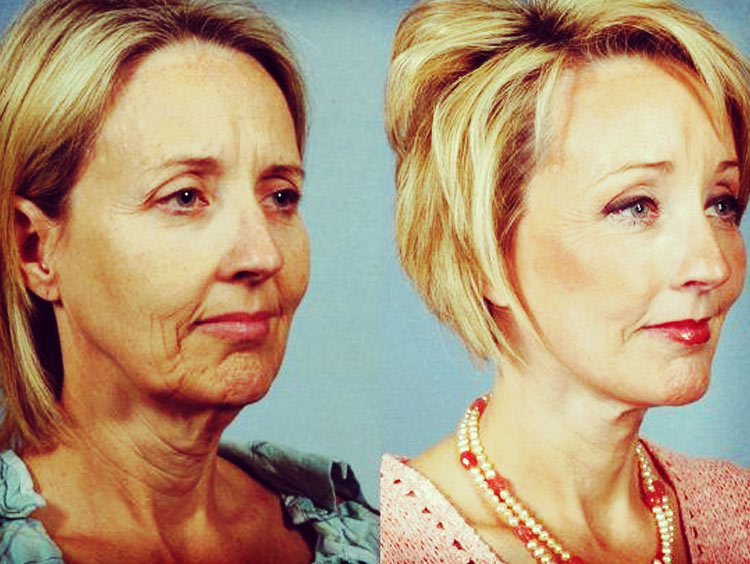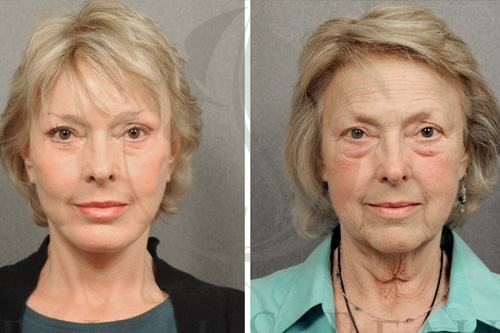Facelift Surgery
Facelift surgery lifts and firms sagging facial tissues to restore a more naturally youthful facial appearance. During a face-lift, a flap of skin on each side of the face is pulled back, and tissues below the skin are surgically altered to return the contour of the face to a more youthful shape

What is a facelift?
A facelift, or rhytidectomy, is a surgical procedure that improves visible signs of aging in the face and neck, such as:
- Relaxation of the skin of the face causing sagging
- Deepening of the fold lines between the nose and corner of the mouth
- Fat that has fallen or has disappeared
- Jowls developing in the cheeks and jaw
- Loose skin and excess fat of the neck that can appear as a double chin or “turkey neck”
What are the risks of facelift surgery?
The decision to have plastic surgery is extremely personal and you will have to weigh the potential benefits in achieving your goals with the risks and potential complications of facelift surgery. Only you can make that decision for yourself.
You will be asked to sign consent forms to ensure that you fully understand the procedure and any risks and potential complications.
Facelift risks, while rare, include:
- Anesthesia risks
- Bleeding
- Infection
- Poor wound healing and skin loss
- Facial nerve injury with weakness
- Temporary or permanent hair loss at the incisions
- Fluid accumulation
- Numbness or other changes in skin sensation
- Persistent pain
- Unfavorable scarring
- Prolonged swelling
- Skin irregularities and discoloration
- Sutures may spontaneously surface through the skin, become visible or produce irritation that require removal
- Unsatisfactory results may include: asymmetry, unsatisfactory surgical scar location and unacceptable visible deformities at the ends of the incisions. (it may be necessary to perform an additional surgery to improve your results)
- Deep vein thrombosis, cardiac and pulmonary complications
Who is a good candidate for a facelift?
Facelift surgery is a highly individualized procedure. You should do it for yourself, not to fulfill someone else’s desires or to try to fit any sort of ideal image.
In general, good candidates for a facelift include:
- Healthy individuals who do not have medical conditions that impair healing
- Nonsmokers
- Individuals with a positive outlook and realistic expectations
How should i prepare for a facelift?
In preparing for a facelift, you may be asked to:
- Get lab testing or a medical evaluation
- Take certain medications or adjust your current medications
- Apply certain products to the facial skin preoperatively
- Stop smoking
- Avoid taking aspirin, anti-inflammatory drugs and herbal supplements as they can increase bleeding and bruising
A facelift may be performed in an accredited office-based surgical facility, licensed ambulatory surgical center, or a hospital. You must arrange for a friend or family member to drive you to and from surgery and to stay with you the first night following surgery.
What are the steps of a facelift procedure?
A facelift procedure includes the following steps:
1 – anesthesia
medications are administered for your comfort during the surgical procedure. The choices include intravenous sedation and general anesthesia. Your doctor will recommend the best choice for you.
A variety of other procedures can further enhance the outcome of a facelift. They include:
Facial implants or fat transfer to improve contour
resurfacing techniques to improve the tone and texture of facial skin
wrinkle reduction by injection of fat or fillers
2 – the incision
depending on the degree of change you’d like to see, your facelift choices include a traditional facelift, limited incision facelift or a neck lift.
A traditional facelift incision often begins in the hairline at the temples, continues around the ear and ends in the lower scalp. Fat may be sculpted or redistributed from the face, jowls and neck and underlying tissue is repositioned, commonly the deeper layers of the face and the muscles are also lifted. Skin is redraped over the uplifted contours and excess skin is trimmed away.
3 – closing the incisions
the incisions will be closed with sutures that may dissolve or may need to be removed after a few days. Some surgeons use skin glues to seal the incisions. Once healed, the incision lines from a facelift are well concealed within the hairline and in the natural contours of the face and ear.
4 – see the results
the visible improvements of a facelift appear once swelling and bruising subside. Your final result should not only restore a more youthful and rested appearance, but also help you feel more confident about yourself. Get more information about facelift results.
What results should i expect after a facelift?
While most people are presentable to the public within 10-14 days, it will take 2-3 months for the face to feel “back to normal” in terms of texture, sensibility and loss of tightness.
Continuing daily sun protection and a healthy lifestyle will help extend the results of your facelift.
As swelling and bruising subside, the visible improvements of a facelift appear. Your final result should not only provide a more youthful and rested appearance, but also help you feel more confident about yourself.
Although good results are expected, there can be no guarantee. In some situations, it may not be possible to achieve optimal results with a single surgical procedure and another surgery may be necessary.
Follow your physician’s instructions to ensure the success of your surgery.
Cost of facelift surgery in Turkey
The cost of the operation cannot be determined before examining the case with the doctor




